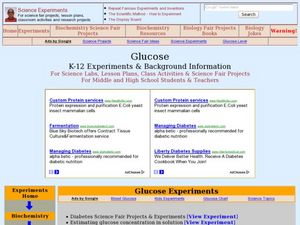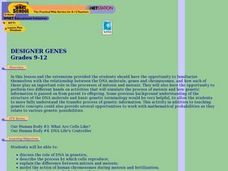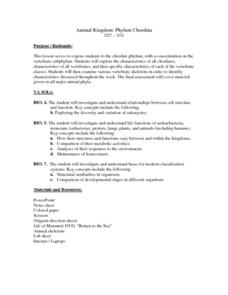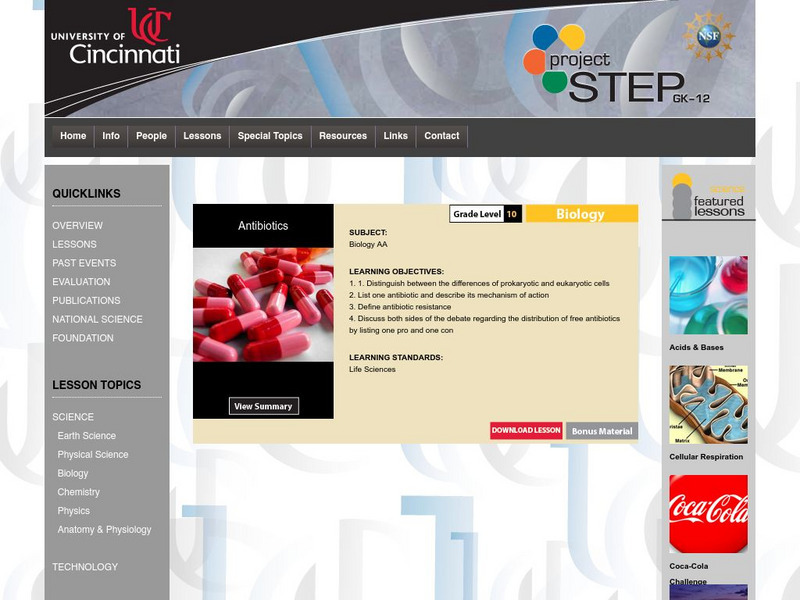Curated OER
Glucose
Young scholars conduct various experiments on glucose. In this biology lesson, students differentiate the process of diffusion and osmosis. They test different foods for the presence of glucose and starch.
Curated OER
Birth of the Earth
Students examine the major events that have taken place in the Earth's development. In this Earth lesson students view a video and put major events in chronological order.
Curated OER
Bacteria and Illness
High schoolers research information on bacterium and their relationship to food borne diseases. In this science lesson plan, students complete internet research to construct and analyze the growth cure of common bacterium...
Curated OER
Gaia: The Wisdom of the Earth
Learners are introduced to Gaia theory of natural homeostasis. They graph Earth's temperatures over time, construct terrariums or monitor the outdoor environment. Related videos titles are suggested, but may be outdated. The objectives...
Curated OER
Chromosomes
Students explore genetics, chromosomes and DNA. In this genetics lesson students design a chromosome and identify a family tree through genetics.
Curated OER
Designer Genes
Pupils view a video on DNA. They discuss mitosis, meiosis and fertilization. They use strips of paper to simulate fertilization and analyze the genotype and phenotype of the combined chromosomes.
Curated OER
Gene Regulation Mechanisms
Students explore the control of expression of DNA into proteins which is divided into two main categories: transcriptional and post-transcriptional. They construct examples of the control mechanisms and discuss disease processes that...
Curated OER
BIoluminescence
Students investigate the concept of bioluminescence. They use dinoflagellates in a lab situation to study photosynthesis. They conduct research into the concept using a variety of resources. Also the class is taken on a field trip to...
Curated OER
DNA: The Search for the Genetic Material
Young scholars study the history of DNA and how to extract it. For this genetic lesson students complete a DNA experiment using bacteria.
Curated OER
DNA replication
Students write an essay on the basic steps of the DNA replication process accurately enough to show a complete understanding of the subject. Finally, student correctly identify the polarity of the template strand and match the correct...
Curated OER
World of Protists
Students observe a jar of pond water and predict how much life they think exists in the jar and watch a "Bill Nye: The Science Guy" video regarding protists. They participate in an online virtual pond dip where they begin to familiarize...
Curated OER
An Introduction to Dichotomous Keys
Young scholars pretend to be shark biologists employed by the National Oceanic and Atmospheric Administration (NOAA) who have been flown into the coastal city of Sao Luis in Brazil because locals have noticed an unidentified shark at...
Curated OER
Plant Classification
High schoolers share with the class how they think plants are classified and are assessed on their prior knowledge. They use a packet to complete throughout the week at their own pace, which includes various activities to familiarize...
Curated OER
The Effects of Ultra-Violet Light on Yeast
Pupils work in small groups collecting and analyzing data as they learn how to best grow yeast. This lesson plan allows students to conduct several student-created experiments as they continually generate questions and hypotheses. ...
Curated OER
Animal Kingdom: Phylum Chordata
Learners use a dichotomous key to classify various vertebrate jar speciments into classes. They examine the speciments for general characteristics of each class and fill in a corresponding chart and then complete a few final assessment...
Curated OER
Invertebrate Classification
Young scholars discuss the recent disovery of the "furry lobster" to peak interest in the animal kingdom. They classify various speciments using invertebrate dichotomous keys, identifying major animal phyla and classes. Thy the complete...
Alabama Learning Exchange
Alex: Inside the Cell
In this lesson, students learn the different kinds of cells including plant and animal cells. They also learn how to identify and name the organelles of eukaryotic cells.
Alabama Learning Exchange
Alex: Cells
Middle schoolers will research prokaryotic and eukaryotic cells. The students will then research plant and animal cells, comparing and contrasting the two. Middle schoolers will also research the major organelles and the function of...
Alabama Learning Exchange
Alex: What's in a Cell?
This lesson focuses on the function of organelles through technology integration. The students will identify the various organelles by using an electronic game. Then, they will construct a Prezi (online presentation) and present their...
TeachEngineering
Teach Engineering: Cell Celebration!
Students look at the components of cells and their functions. The lesson focuses on the difference between prokaryotic and eukaryotic cells. Each part of the cell performs a specific function that is vital for the cell's survival....
Alabama Learning Exchange
Alex: Building a Cell: Edible Cell Project
Students will create an Eukaryotic cell from materials that they can eat. Students will need to have a lesson on the types of Eukaryotic cells and its organelles before they complete this assignment. Students will construct these...
Science Education Resource Center at Carleton College
Serc: Observe, Describe, Compare and Contrast Cells
This investigation allows students to observe cells from multiple sources. Plant, animal and bacterial cells will be observed as well as cells from multicellular organisms and single-celled organisms. After providing written descriptions...
Alabama Learning Exchange
Alex: Cells! Cells! Cells!
Young scholars will learn about both POP Art and science in this pattern project. Working in conjunction with a science teacher in your school, students will view cells through a microscope and use visual diaries to create pattern...
Other
University of Cincinnati: Project Step: Antibiotics
STEM biology instructional activity where by designing their own antibiotics, students will gain an understanding of how the differences between prokaryotic cells and eukaryotic cells have played a role in their own health. They will...























